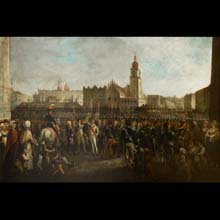
material: oil on canvas
dimensions: 120 x 179 cm
description: Tadeusz Kościuszko’s heroic conduct won him enormous popularity in the Polish society. It was also a result of his successes and awards from the time of the wars in America in the 1770s and 1780s and fighting against the Russian army in 1792, his ostentatious resignation from the function of a general of the Polish army after king Stanisław August had joined the Targowica Confederation and the fact that France awarded him honorary citizenship for his struggle for freedom. The aristocracy saw Kościuszko as the leader of an uprising against Russia>, which carried out the Second Partition of Poland with Prussia in 1793. Measuring up to these expectations, Kościuszko led the insurrection. On March 24, 1794, he assumed the powers of the Commander in Chief of the National Armed Forces in the Market Square in Krakow, in the presence of the representatives of the whole society, namely the army, the merchant congregation, guilds, the clergy, townsfolk and peasants. He took the following oath: “I swear before God and the whole Polish Nation that I shall not employ the authority vested in me for anyone’s private benefit, but for the integrity of the borders, for regaining national sovereignty and for the establishment of general liberty. Michał Stachowicz, a guild painter from Krakow, depicted this event on canvas, and due to enormous demand, he also painted several replicas of the work. The artist probably painted this version in 1821, on commission of the Municipality of Krakow. Barbara Ciciora
exposition: The Gallery of 19th Century Polish Art in Sukiennice,
The Cloth Hall, 1, Main Market Square
key: Romanticism. Towards national art >>>
dimensions: 120 x 179 cm
description: Tadeusz Kościuszko’s heroic conduct won him enormous popularity in the Polish society. It was also a result of his successes and awards from the time of the wars in America in the 1770s and 1780s and fighting against the Russian army in 1792, his ostentatious resignation from the function of a general of the Polish army after king Stanisław August had joined the Targowica Confederation and the fact that France awarded him honorary citizenship for his struggle for freedom. The aristocracy saw Kościuszko as the leader of an uprising against Russia>, which carried out the Second Partition of Poland with Prussia in 1793. Measuring up to these expectations, Kościuszko led the insurrection. On March 24, 1794, he assumed the powers of the Commander in Chief of the National Armed Forces in the Market Square in Krakow, in the presence of the representatives of the whole society, namely the army, the merchant congregation, guilds, the clergy, townsfolk and peasants. He took the following oath: “I swear before God and the whole Polish Nation that I shall not employ the authority vested in me for anyone’s private benefit, but for the integrity of the borders, for regaining national sovereignty and for the establishment of general liberty. Michał Stachowicz, a guild painter from Krakow, depicted this event on canvas, and due to enormous demand, he also painted several replicas of the work. The artist probably painted this version in 1821, on commission of the Municipality of Krakow. Barbara Ciciora
exposition: The Gallery of 19th Century Polish Art in Sukiennice,
The Cloth Hall, 1, Main Market Square
key: Romanticism. Towards national art >>>












